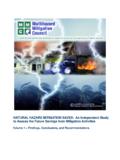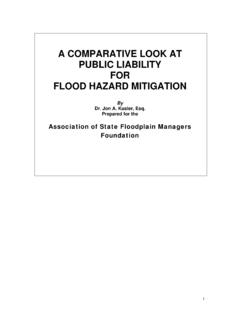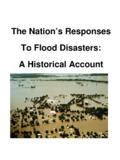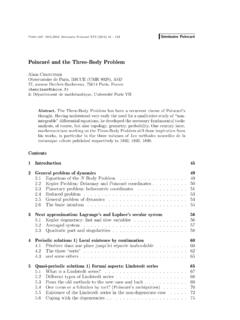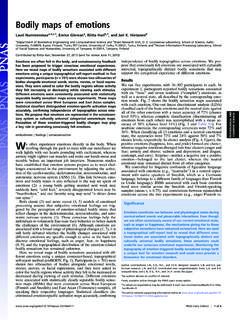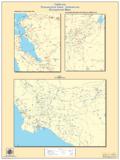Transcription of Body of Knowledge 121507 - ASFPM
1 Revised -- 121507 - 1 -Association of State Floodplain Managers Floodplain Management body of Knowledge Floodplain management is a process that promotes the wise use of floodplains in order to minimize flood risks, reduce losses from floods, protect public health and safety, and improve the quality of life for a community These management activities should also not adversely impact the natural environment. Floodplain managers usually specialize in one or more aspects of floodplain management. The Certified Floodplain Manager (CFM ) program promotes a level of expertise in the National Flood Insurance Program (NFIP). Certified Floodplain Managers are expected to have a working Knowledge of: a.
2 Flood studies and maps b. NFIP Rules and Regulations c. Regulatory standards d. Ordinance administration e. Flood insurance f. Hazard mitigation g. Natural and beneficial floodplain functions The NFIP serves as the basis for our profession. This Program does not comprise all the aspects of floodplain management. A certified floodplain manager should strive to have a working Knowledge of a broad array of topics. The topics listed below form a comprehensive body of Knowledge that is needed to effectively manage floodplains. The list is arranged by topic and the order does not imply a level of importance. All topics do not have equal weight in floodplain management. It is not intended to be a comprehensive list of every aspect of floodplain management, but a tool to: Guide the Certification Board of Regents and Individual CFM in identifying training needs.
3 Floodplain Management body of Knowledge 1. The physical processes operating on the stream channel, shoreline, floodplain and watershed a. Effects of Global Warming b. Hydrologic cycle influences c. Formation and evolution of river basins, rivers, and shorelines d. Sediment production and mobilization e. Relationship of the river corridor to coastal processes. 2. The biological processes active in the floodplain a. Ecological principles and biological processes b. Stream and river ecology c. Water quality effects on biological processes, recreation, water supply, aesthetics Revised -- 121507 - 2 -3. Human interactions with floodplains and drainage basins a. Reasons for riverside and coastal development b.
4 Historic development in the US c. Impact of land cover and human development on the physical and biological processes d. History of government responses e. Institutional framework for government programs f. Cultural biases that influence human behavior and management decisions 4. Risk assessment models a. Floodplain Mapping models (HEC RAS). a. Data collection tools and accuracy (gages, remote sensing, LIDAR, ) b. Hydrology and hydraulic principles c. Uses of GIS and Spatial analytic tools d. Water quality measurement (biological or chemical oxygen ) e. Ecological risk assessment f. Hazards US (HAZUS) g. Standard hydrologic and hydraulic models and varying limits of accuracy h. Coastal models and methodology and limitations i.
5 Mapping scales, vertical and horizontal datum j. Mapping scale and data precision k. Interpretation of topographic data l. Benefit/cost analysis 5. Policy, guidance and plans a. Hazards Insurance b. Statutory and regulatory authority and responsibility c. Legal obligations and constraints, Property Rights and responsibility, other specialized areas such as public trust doctrine. d. Planning processes (Issues, goals, objectives, policies, programs, strategies, ) e. Zoning processes (guiding development away from hazardous areas) f. Code compliance, administration and enforcement. g. Subdivision regulations (setting the pattern and infrastructure of development) h. Stormwater and watershed management processes (detention, retention, best management practices) i.
6 Natural areas rehabilitation, conservation and restoration (wetlands regulations, sensitive areas regulations, greenways, buffer areas, overlay districts ) j. Coastal zone processes (erosion control, dune and beach protection) k. Sedimentation, erosion and water velocity management l. Other specific watershed management activities that might not be included above. (water supply, water quality) m. Building codes Revised -- 121507 - 3 -6. Management skills a. Partnering with related disciplines (planning, emergency management, architecture and landscape architecture) b. Working with teams and groups c. Communication and presentation skills (written, ) d. Time management e. Managing people f. Arbitration and conflict resolution g.
7 Project planning h. Ethics i. ICS j. Outreach skills (developing an outreach programs, ) k. Consensus and coalition building ability 7. Role in mitigation a. Community Rating System (CRS) b. Unified National Program c. Sustainable development, Smart Growth d. No Adverse Impact (NAI), e. Mitigation Operations Manual (MOM) f. Low impact development (LID) g. FireWise, TsunamiReady, h. Executive Order 11988 i. Project Impact j. Specific hazards mitigation tools (floodproofing, structural flood controls, retrofitting and acquisition) k. Other holistic watershed management programs (stormwater, protection & restoration, water supply, water quality, water & sewer master planning, land use planning) l.
8 Use and understanding of Increased Cost of Compliance m. Substantial Damage determinations 8. Role in preparedness, response and recovery operations a. Emergency response (warning, evacuation, ) b. Disaster recovery (Stafford Act Sections 404 and 406, National Response Plan ESF 14, identifying mitigation opportunities through response and recovery ) c. Debris Management d. Mutual Aid compacts and agreements 9. Organizations, agencies, and programs a. Federal agencies and programs (FEMA, EPA, NOAA, HUD USGS, USACE, USDA ) b. State agencies and programs c. Local agencies and programs d. Professional / Trade organizations ( ASFPM , ASCE, APA, ASDSO, ) e. Environmental organizations (National Wildlife Federation, beach protection groups) f.
9 Public interest organizations (American Red Cross, Land Trust Alliance, IBHS, NSC, MCO, NEMA .. ) g. Business organizations, (Chamber of ) h. Schools and school programs (Project ) i. Community/faith based organizations (World Vision, Mercy )

